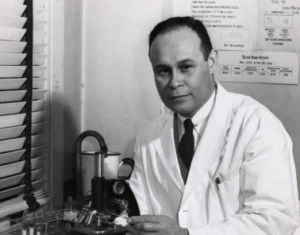
Dr. Charles Drew was a surgeon and researcher known for his groundbreaking work in the field of blood preservation, as well as for his dedication to the education of other Black surgeons. Dr. Drew is named as a co-inventor on two patents related to surgical tools: U.S. Patent No. 2,389,355 for a “surgical needle” and U.S. Patent No. 2,397,257 for a “surgical suction apparatus.”
Dr. Drew was born in Washington, D.C. and attended Amherst College on an athletic scholarship. After graduation, became a science professor and football coach at Morgan State University, where he worked to save money for medical school. As a medical student, he began research related to treating medical shock with blood transfusions. At the time, however, there were no methods available to safely store or transport large quantities of blood, limiting the utility of transfusions for this application.
Later, he joined the faculty at the Howard University College of Medicine where he continued this research. Against the backdrop of World War II, he completed his dissertation titled “Banked Blood.” At the time, there was a dire need for sterile, accessible blood products—in particular, plasma—to treat wounded soldiers overseas. Dr. Drew joined the project “Blood for Britain,” affiliated with the American Red Cross, as the medical director to assist with this effort. He later became the medical director for New York City’s Red Cross blood bank, where he piloted the use of refrigerated trucks as mobile units for blood collection and storage. During his years as an innovator in this field, he also tirelessly advocated against the Red Cross’s racist policy of segregating blood plasma by race. As a result, received the Spingarn Medal from the NAACP in 1933.
Dr. Drew then returned to Howard University, where he became the chief of surgery and chief surgeon at its affiliated hospital. He dedicated the latter years of his career to training Black surgeons, determined to address racism in the medical community by encouraging excellence. Despite his pioneering research in blood preservation, in a 1947 letter, he described teaching the men he trained as what he believed to be his “greatest contribution to medicine.”
Tragically, Dr. Drew passed away unexpectedly in a car accident in the spring of 1950. But his legacy—both in facilitating the success of other Black surgeons and in enhancing the safety and reliability of blood transfusions—lives on. This Black History Month, we celebrate Dr. Charles Drew and his contributions to a more equitable medical system for all.
Author: Hannah Mosby O’Brien
